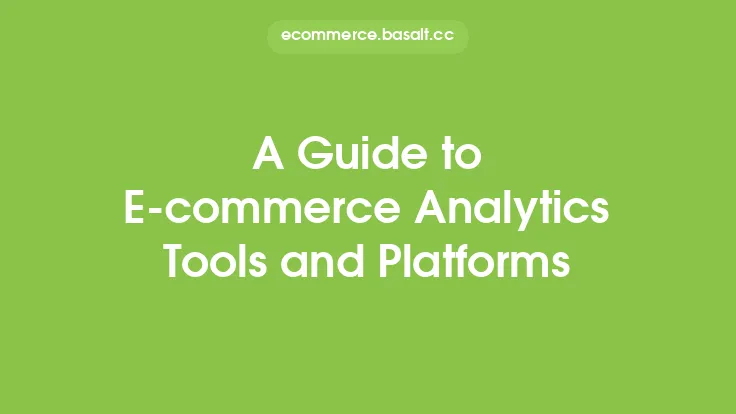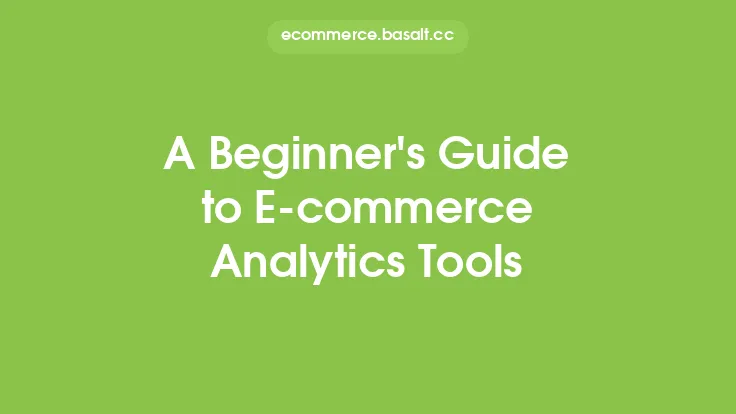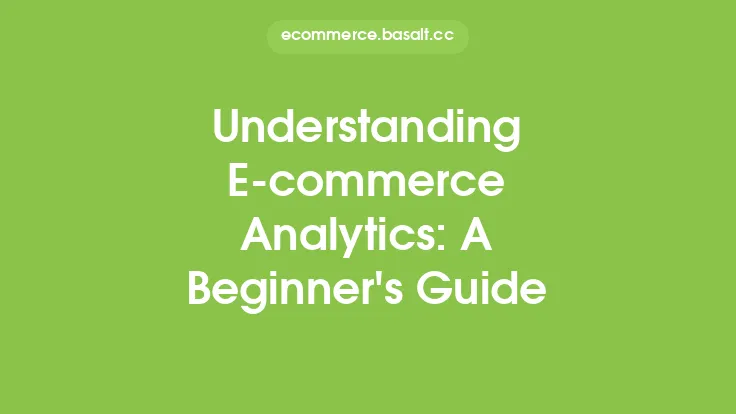As an e-commerce business owner, having access to the right analytics tools and platforms is crucial for making informed decisions and driving growth. With so many options available, it can be overwhelming to choose the best tools for your business. In this article, we will explore the world of e-commerce analytics, discussing the different types of tools and platforms available, their features, and how to choose the best ones for your business.
Introduction to E-commerce Analytics Tools
E-commerce analytics tools are software applications that help businesses track and analyze their online sales, customer behavior, and marketing performance. These tools provide insights into key performance indicators (KPIs) such as conversion rates, average order value, and customer retention. By using e-commerce analytics tools, businesses can identify areas of improvement, optimize their marketing strategies, and increase revenue.
Types of E-commerce Analytics Tools
There are several types of e-commerce analytics tools available, each with its own unique features and benefits. Some of the most common types of tools include:
- Web analytics tools: These tools track website traffic, behavior, and conversion rates. Examples include Google Analytics and Adobe Analytics.
- Social media analytics tools: These tools track social media performance, including engagement rates, follower growth, and conversions. Examples include Hootsuite Insights and Sprout Social.
- Email marketing analytics tools: These tools track email marketing performance, including open rates, click-through rates, and conversion rates. Examples include Mailchimp and Constant Contact.
- Customer analytics tools: These tools track customer behavior, including purchase history, browsing behavior, and demographic data. Examples include Salesforce and HubSpot.
Features of E-commerce Analytics Tools
E-commerce analytics tools offer a range of features that help businesses track and analyze their online performance. Some of the most common features include:
- Data visualization: This feature provides interactive and customizable dashboards that help businesses visualize their data and identify trends.
- Real-time tracking: This feature allows businesses to track their data in real-time, enabling them to respond quickly to changes in their online performance.
- Segmentation: This feature allows businesses to segment their data by demographics, behavior, or other criteria, enabling them to target specific customer groups.
- A/B testing: This feature allows businesses to test different versions of their website, email campaigns, or social media ads to determine which ones perform better.
Choosing the Right E-commerce Analytics Tools
With so many e-commerce analytics tools available, choosing the right ones for your business can be challenging. Here are some factors to consider when selecting e-commerce analytics tools:
- Ease of use: Choose tools that are easy to use and require minimal technical expertise.
- Integration: Choose tools that integrate with your existing e-commerce platform, marketing software, and other business systems.
- Cost: Choose tools that fit within your budget and offer a good return on investment.
- Scalability: Choose tools that can grow with your business and handle increasing amounts of data.
- Customer support: Choose tools that offer good customer support, including documentation, tutorials, and support teams.
Popular E-commerce Analytics Platforms
Some popular e-commerce analytics platforms include:
- Google Analytics: A web analytics tool that tracks website traffic, behavior, and conversion rates.
- Adobe Analytics: A web analytics tool that tracks website traffic, behavior, and conversion rates, with advanced features such as predictive analytics and customer profiling.
- Shopify Analytics: An e-commerce analytics tool that tracks sales, customer behavior, and marketing performance for Shopify stores.
- Magento Analytics: An e-commerce analytics tool that tracks sales, customer behavior, and marketing performance for Magento stores.
- Mixpanel: A customer analytics tool that tracks customer behavior, including purchase history, browsing behavior, and demographic data.
Best Practices for Using E-commerce Analytics Tools
To get the most out of e-commerce analytics tools, businesses should follow best practices such as:
- Setting clear goals and objectives: Define what you want to achieve with your e-commerce analytics tools and set clear goals and objectives.
- Tracking key performance indicators (KPIs): Track KPIs such as conversion rates, average order value, and customer retention to measure your online performance.
- Analyzing data regularly: Regularly analyze your data to identify trends, opportunities, and challenges.
- Taking action: Take action based on your data analysis, such as optimizing your website, email campaigns, or social media ads.
- Continuously monitoring and improving: Continuously monitor and improve your e-commerce analytics tools and strategies to ensure you are getting the most out of your data.
Common Challenges and Limitations of E-commerce Analytics Tools
While e-commerce analytics tools offer many benefits, there are also common challenges and limitations to consider. Some of these challenges and limitations include:
- Data quality issues: Poor data quality can lead to inaccurate insights and decisions.
- Integration challenges: Integrating e-commerce analytics tools with existing business systems can be challenging.
- Cost and complexity: Some e-commerce analytics tools can be expensive and complex to use, requiring significant technical expertise.
- Data overload: With so much data available, it can be challenging to identify the most important insights and take action.
Future of E-commerce Analytics Tools
The future of e-commerce analytics tools is exciting, with emerging trends such as artificial intelligence (AI), machine learning (ML), and the Internet of Things (IoT) set to revolutionize the industry. Some potential developments include:
- Predictive analytics: E-commerce analytics tools will use AI and ML to predict customer behavior and preferences.
- Personalization: E-commerce analytics tools will enable businesses to personalize their marketing and customer experiences based on individual customer data.
- Real-time analytics: E-commerce analytics tools will provide real-time insights and recommendations, enabling businesses to respond quickly to changes in their online performance.
- Integration with emerging technologies: E-commerce analytics tools will integrate with emerging technologies such as voice commerce, augmented reality, and virtual reality.





